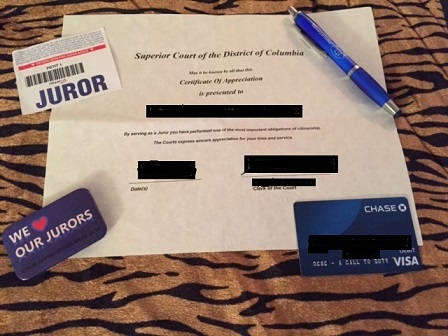 For weeks, I dreaded it. As the time grew closer, I accepted the inevitable. There was no avoiding it. Sooner or later, I would have to do it. Sometimes to avoid thinking about it, I would create a mental list of things that I would rather do: listen to someone talk with their mouthful of food, step in chewing gum, or have a root canal. Dozens of other things came to mind. Things that I would rather do than IT. But alas, I knew I would have to comply with government orders or suffer the consequences. So, when the day arrived, I obeyed the summons and reported to the courthouse to do it – jury duty.
For weeks, I dreaded it. As the time grew closer, I accepted the inevitable. There was no avoiding it. Sooner or later, I would have to do it. Sometimes to avoid thinking about it, I would create a mental list of things that I would rather do: listen to someone talk with their mouthful of food, step in chewing gum, or have a root canal. Dozens of other things came to mind. Things that I would rather do than IT. But alas, I knew I would have to comply with government orders or suffer the consequences. So, when the day arrived, I obeyed the summons and reported to the courthouse to do it – jury duty.
As incredible as it is, I know people who enjoy jury duty, but I’m not one of them. I resent spending hours sitting in the Juror Lounge feeling as bored as an egotist at a humility conference. Nor do I look forward to being in a closed room deliberating with a group of argumentative jurors. Been there. Done that. Never want to do it again.
Like many District of Columbia residents, I receive a jury summons about every two years. If I were an irresponsible person, I would do what some defiant citizens do when summoned. Ignore it. In 2014, 70,000 people in the District of Columbia ignored the order to report for jury service.
There are consequences for being a no-show. The penalties vary from state-to-state. In DC, not reporting for jury service could result in a bench warrant for your arrest for contempt of court. In 2008, a DC Superior Court judge, fed-up with the no-shows, issued arrest warrants for 92 District residents. Shirkers take note. Failure to answer a jury summons means that you could (1) go to jail for several days (Do not pass go and do not collect $200) or (2) pay a fine that could cost upward of $300.
Perhaps because the reluctance of the populace to serve is so prevalent, many states and the District of Columbia are adopting new practices to raise awareness of the importance of jury service, to improve the experience, and to offer incentives for citizens to report when summoned.
In years past, after signing in at the Juror’s Office, potential jurors would sit in the Lounge and wait, along with a few hundred other folks, until a clerk arrived. After greeting us, she or he would switch on an instructional video about the juror proceedings on the overhead monitors. An old movie usually followed the video. Two years ago, the feature was The Secret Life of Bees. I had already seen it in the theater. It wasn’t a film I would voluntarily watch twice, but I forgot to bring reading material, so I watched it again, between naps.
My recent experience as a Petit Juror occurred during Juror Appreciation Week. Things were somewhat different than they were during my assignment a couple of years earlier. At the appropriate time, the jury clerk entered the Lounge. She thanked us for our service and then introduced a court official who gave a pep talk about why we were there. He emphasized the importance of our role in the administration of justice and peppered his spiel with humor. It was a nice effort to make us feel better about being on lockdown for “one day or one trial.”
After receiving the warning that if assigned to a trial, “You may not, under any circumstance, tweet, Facebook, Instagram, use Google or any social media” to do research about the case, the clerk invited us to help ourselves to the refreshments set up on the tables in the rear of the Lounge.
During Juror Appreciation Week, potential jurors get amenities not usually offered. In addition to coffee, juice and light snacks we received a pen engraved with the courthouse logo; a Certificate of Appreciation on parchment paper; a button reading “We [heart] our jurors” and a bank debit card loaded with four bucks. A $4 stipend for transportation might buy one gallon of gas or a round trip bus ride.
I passed on the snacks. Instead, I pulled out my book from my purse and prepared myself for the long haul that wound up being shorter than expected.
The first best thing to happen to me that day was that we jurors who did not get assigned to a panel were dismissed early, around 2:30 PM instead of the usual 4 or 5. The next best thing was knowing that it would be a few years before another jury summons turns up in my mailbox. IT wasn’t so bad that last time.
Back in November 2011, I wrote a four-part series about jury duty. To read it, click here.
